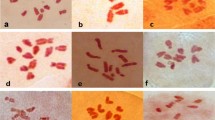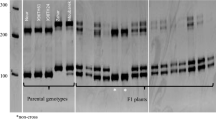Abstract
Identification of homozygous lines is a prerequisite for commercial sugarcane cultivation through true seed, which will bring a transformational change in sugarcane agriculture. In order to explore this possibility, several commercial canes were selfed and the selfs were evaluated for economic traits and molecular similarity. Among the families, Co 1148 family contained advanced generation selfs, while others were of early generations. The families Co 1148, Co 86032, Co 99008 recorded the least variability for cane yield and quality traits, while Co 775 families exhibited the highest variability. On genotyping with eleven sequence tagged microsatellite markers and subjecting the data to STRUCTURE analysis revealed 9, 4, 4 and 2 subpopulations in Co 1148, Co 86032, Co 99008 and Co 775 families, respectively. In each family, clone(s) amplifying least number of markers within each allele and having highest genomic differentiation in relation to the parent are considered as relatively homozygous types. One such identified sixth generation self, viz. 1148-13-11-2-237-2-61 was selfed and crossed with other identified near homozygous lines, and the progenies were compared for their homogeneity. The hybrid progeny populations recorded lower coefficient of variation and exhibited high hybrid vigour over the corresponding selfed progenies. The results implied the scope of hybrid breeding and true seed production in sugarcane through developing homozygous selfs. The identified near homozygous selfs need to be further advanced and investigated for their utilisation as parents in sugarcane true seed production programme.









Similar content being viewed by others
References
Adamack, A.T., and B. Gruber. 2014. PopGenReport: Simplifying basic population genetic analyses in R. Methods in Ecology and Evolution 5(4): 384–387. https://doi.org/10.1111/2041-210X.12158.
Doyle, J.J., and J.L. Doyle. 1987. A rapid DNA isolation procedure for small quantities of fresh leaf tissue. Phytochemical Bulletin 19: 11–15.
Durai, A.A., G. Hemaprabha, R. Kumar, and K. Mohanraj. 2012. Effects of selfing on important economic traits in sugarcane (Saccharum spp.). Journal of Sugarcane Research 2(2): 29–33.
Durai, A.A., and G. Hemaprabha. 2016. Heterosis and combining ability of sugarcane inbredsfor early stage selection traits. Journal of Sugarcane Research 6(1): 27–34.
Durai, A.A., G. Hemaprabha, V.R. Viola, T.S.S. Padmanaban, and K. Lakshmi. 2019. Studies on economic traits in successive generations of selfing in sugarcane (Saccharum spp.). Journal of Sugarcane Research 9(2): 119–129.
Earl, D.A., and B.M. Von Holdt. 2012. STRUCTURE HARVESTER: A website and program for visualizing STRUCTURE output and implementing the Evanno method. Conservation Genetics Resources 4(2): 359–361. https://doi.org/10.1007/s12686-011-9548-7.
Evanno, G., S. Regnaut, and J. Goudet. 2005. Detecting the number of clusters of individuals using the software STRUCTURE: A simulation study. Molecular Ecology 14(8): 2611–2620.
Ethirajan, S.A., P.N. Santhakumariamma, and N. Velayutham. 1978. Studies on successive inbred generations of selected sugarcane cultivars. Proceedings of the XVI International Society of Sugarcane Technologists Congress, Sao Paulo, 269–273.
Ferreira, F.M., M.H.P. Barbosa, R.D. de Castro, L.A. Peternelli, and C.D. Cruz. 2005. Effects of inbreeding on the selection of sugar cane clones. Crop Breeding and Applied Biotechnology 5: 174–182.
Goudet, J. and T. Jombart. 2020. hierfstat: Estimation and Tests of Hierarchical F-statistics. R package version 0.5-7. https://CRAN.R-project.org/package=hierfstat.
Hemaprabha, G., U.S. Natarajan, N. Balasundaram, and N. Subramonian. 2000. Quantification of genetic similarity among inbred progenies and identification of desirable parents for population development in sugarcane (Saccharum spp.) through isozyme analysis, 16–18. Sugar Cane International.
Hemaprabha, G., U.S. Natarajan, and N. Balasundaram. 2003. Breeding behaviour for juice quality through selfing and progeny evaluation in hybrid clones and inbred derivatives of sugarcane (Saccharum spp.). Sugar Tech 5(3): 177–200.
Hemaprabha, G., and N.K. Singh. 2007. Evaluation of parental value of selfs in sugarcane (Saccharum spp.) breeding. The Indian Journal of Genetics and Plant Breeding 67(3): 248–253.
Hogarth, D.M. 1980. The effect of accidental selfing on the analysis of a diallel crosses with sugarcane. Euphytica 29: 737–746.
Jombart, T. 2008. adegenet: A R package for the multivariate analysis of genetic markers. Bioinformatics 24: 1403–1405. https://doi.org/10.1093/bioinformatics/btn129.
Kamvar, Z.N., J.F. Tabima, and N.J. Grünwald. 2014. Poppr: An R package for genetic analysis of populations with clonal, partially clonal, and/or sexual reproduction. PeerJ 2: e281. https://doi.org/10.7717/peerj.281.
Mettler, L.E., and T.G.C. Gregg. 1973. Genetica de Populacoes Poligono/EDUSP, Sau Paula, 262.
Neel, J.V., and E.A. Thompson. 1978. Founder effect and number of private polymorphisms observed in Amerindian tribes. Proceedings of the National Academy of Sciences of the United States of America 75: 1904–1908.
Panje, R.L., and A.S. Ethirajan. 1959. Studies on Saccharum spontaneum—Preliminary studies in inbreeding. Proceedings of the X International Society of Sugar Cane Technologists Congress.
Paradis, E. 2010. pegas: An R package for population genetics with an integrated-modular approach. Bioinformatics 26: 419–420.
Pritchard, J.K., M. Stephens, and P. Donnelly. 2000. Inference of population structure using multilocus genotype data. Genetics 155: 945–959.
Ram, B., G. Hemaprabha, and M.N. Premachandran. 2015. Sugarcane cultivation through true seed—A historic step towards changing mode of transportation of sugarcane seed from truck to pocket. SBI Newsletter 35(3): 1–2.
Shanthi, R.M., and S. Alarmelu. 2011. Parental stocks for early high sugar content through simple recurrent selection. SBI News 31(4): 2–3.
Silva, M.A., and P.S. Gonclaves. 2011. Inbreeding in sugarcane varieties. Ciencia Rural, Santa Maria 41(4): 580–586.
Slatkin, M. 1985. Rare alleles as indicators of gene flow. Evolution 39: 35–65.
Stevenson, G.C. 1953. The use of selfing and inbreeding with sugarcane. Proceedingsof the VIII International Society of SugarCane Technologists, 1954, British West Indies, 509–520.
Author information
Authors and Affiliations
Corresponding author
Additional information
Publisher's Note
Springer Nature remains neutral with regard to jurisdictional claims in published maps and institutional affiliations.
Supplementary Information
Below is the link to the electronic supplementary material.
Rights and permissions
About this article
Cite this article
Pathy, T.L., Vinu, V., Annadurai, A. et al. Identification of Near Homozygous Inbred Lines for Developing Hybrid Populations to Explore the Possibility of True Seed-Based Sugarcane Cultivation. Sugar Tech 25, 308–319 (2023). https://doi.org/10.1007/s12355-022-01144-0
Received:
Accepted:
Published:
Issue Date:
DOI: https://doi.org/10.1007/s12355-022-01144-0




